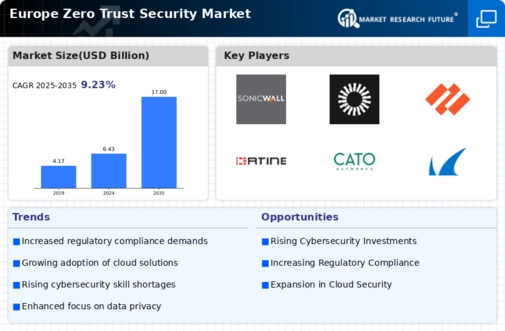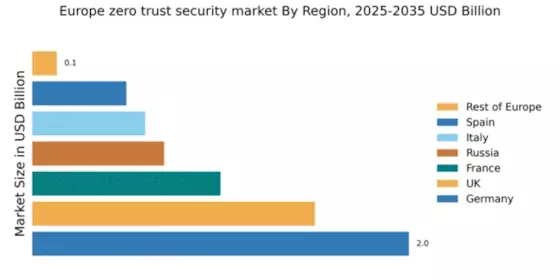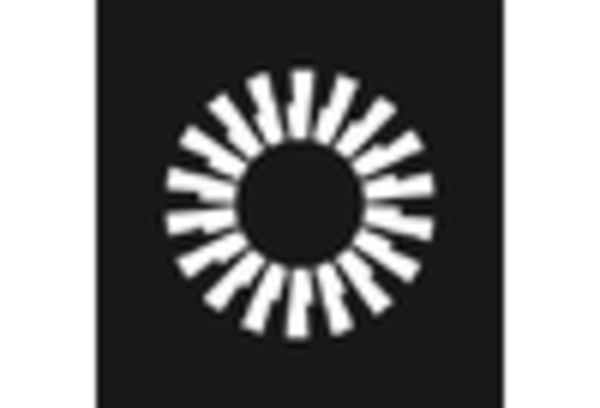Shift Towards Remote Work
The transition to remote work has fundamentally altered the security landscape in Europe, driving demand for zero trust-security solutions. As organizations embrace flexible work arrangements, traditional perimeter-based security models become increasingly inadequate. The zero trust-security market is responding to this shift by offering solutions that secure access to resources regardless of location. According to recent data, approximately 60% of European companies have adopted remote work policies, necessitating a reevaluation of security strategies. This trend is likely to continue, with many organizations recognizing the need for continuous authentication and monitoring of user behavior. Consequently, the zero trust-security market is expected to expand, as businesses seek to protect sensitive data and maintain compliance in a decentralized work environment.
Rising Cyber Threat Landscape
The increasing frequency and sophistication of cyber threats in Europe is a primary driver for the zero trust-security market. Organizations are facing a myriad of attacks, including ransomware and phishing, which have surged by approximately 30% in recent years. This alarming trend compels businesses to adopt more robust security frameworks. The zero trust-security model, which operates on the principle of 'never trust, always verify', is gaining traction as it effectively mitigates risks associated with unauthorized access. As a result, the zero trust-security market is projected to grow significantly, with estimates suggesting a compound annual growth rate (CAGR) of around 20% through 2027. This growth reflects the urgent need for organizations to enhance their security postures in response to evolving threats.
Increased Focus on Data Privacy
Data privacy regulations in Europe, such as the General Data Protection Regulation (GDPR), are significantly influencing the zero trust-security market. Organizations are under pressure to ensure compliance with stringent data protection laws, which mandate the safeguarding of personal information. The zero trust-security model aligns well with these requirements, as it emphasizes strict access controls and continuous monitoring of data access. As of 2025, it is estimated that non-compliance could result in fines amounting to €20 million or 4% of annual global turnover, whichever is higher. This potential financial impact drives organizations to adopt zero trust-security measures to mitigate risks associated with data breaches. The market is likely to see a surge in demand for solutions that facilitate compliance while enhancing overall security posture.
Growing Adoption of Cloud Services
The rapid adoption of cloud services across Europe is a significant driver for the zero trust-security market. As organizations migrate to cloud environments, they face new security challenges that traditional security models cannot adequately address. The zero trust-security framework provides a comprehensive approach to securing cloud applications and data, ensuring that only authorized users have access. Recent statistics indicate that over 70% of European enterprises are utilizing cloud services, which necessitates a shift in security strategies. This trend is expected to continue, with the zero trust-security market projected to grow as businesses seek to protect their cloud assets from unauthorized access and potential breaches. The integration of zero trust principles into cloud security strategies is likely to become a standard practice in the coming years.
Emergence of Advanced Threat Detection Technologies
The emergence of advanced threat detection technologies is reshaping the zero trust-security market in Europe. Innovations such as artificial intelligence (AI) and machine learning (ML) are enhancing the ability to identify and respond to threats in real-time. These technologies enable organizations to analyze vast amounts of data and detect anomalies that may indicate security breaches. As businesses increasingly recognize the value of proactive threat detection, the demand for zero trust-security solutions that incorporate these technologies is expected to rise. The market is likely to experience growth as organizations invest in solutions that not only protect against known threats but also adapt to evolving attack vectors. This trend underscores the importance of integrating advanced technologies into the zero trust-security framework to bolster overall security effectiveness.


















Leave a Comment